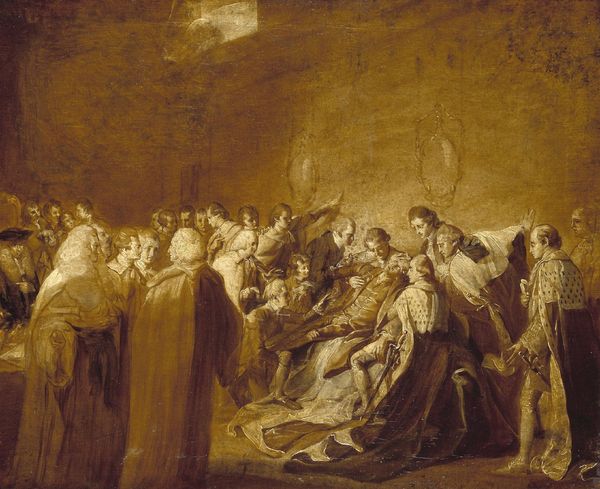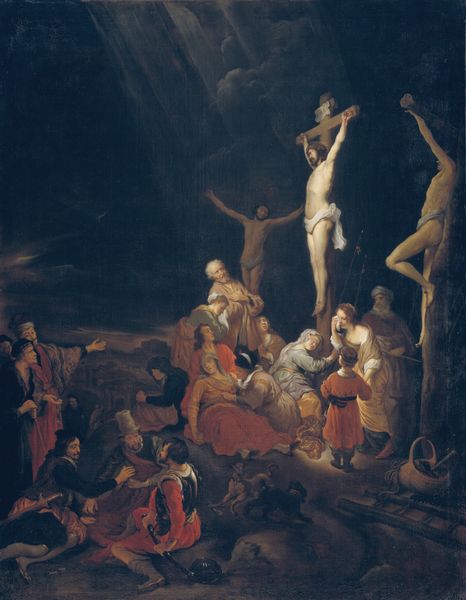
canvas
#
abstract painting
#
impressionist painting style
#
impressionist landscape
#
possibly oil pastel
#
oil painting
#
canvas
#
neo expressionist
#
acrylic on canvas
#
underpainting
#
painting painterly
#
expressionist
Dimensions: 227 cm (height) x 343 cm (width) (Netto)
Curator: Immediately I am struck by a theatrical light bathing the characters in "Allegory of Old Age. Time and the Scholar" by Pieter Isaacsz. The drama of aging! The inevitability! The…slightly awkward positioning of everyone involved. Editor: Pieter Isaacsz created this scene sometime between 1584 and 1625, offering viewers a commentary on the perception, the performance, and perhaps even the burden of wisdom, staged as a collision between mortality and intellect. It’s held at the SMK, Statens Museum for Kunst. Curator: A collision, yes! That's exactly it. There’s the aged figure, almost naked, but draped rather carelessly. Is that supposed to be a toga? And a scholar on the side seems utterly absorbed, seemingly oblivious, or intentionally disregarding, the throng gathered round. And the scholar and the old man each has a prop to symbolize his path: a book or a staff. Editor: It is thought the setting shows Isaacsz’s reaction to changes in Dutch society during the early 17th century. Note that only some in this gathering pay tribute to this personification of old age. Kneeling before this aging man, figures beseech and look on in wonder, even as they handle the attributes that speak to prosperity and wordly success. Curator: Their expressions are captivating—a mixture of reverence, desperation, and curiosity. It’s a potent reminder that even with accumulated wisdom or achievements, the realities of aging bring vulnerability. They highlight our complicated relationships with wisdom and experience! It also makes me ponder on my own aging... are my best insights behind or yet to come? It can be disquieting, no? Editor: Indeed. This contrast between acclaim and disinterest towards age is potent social commentary, questioning the true value placed on accumulated knowledge and lived experience. I am thinking that this artist must have been feeling that older people, older ways, were perhaps losing importance with social changes brought on with new discoveries and increasing colonial wealth. Curator: Maybe there's something universally, and darkly funny, about that spectacle, about Time personified being both celebrated and, essentially, ignored by those wrapped up in their scholarly pursuits, their beads, their riches… Maybe Isaacsz wants us to confront that funny and somber dance between wisdom and oblivion. Editor: Isaacsz clearly invites a layered reflection on value and visibility, especially as culture advances forward. He calls our attention to the complexities within generational dynamics, questioning which figures and facets of the past are honored, revered, and carried forward—and perhaps also, which are regrettably forgotten.
Comments
No comments
Be the first to comment and join the conversation on the ultimate creative platform.













